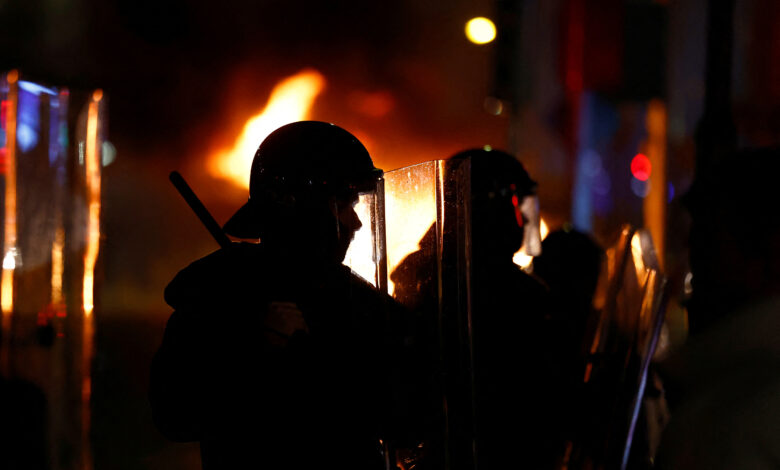Blame immigration surge into Ireland, not ‘right-wingers’, for Dublin riots

DUBLIN — In the 12 months to April this year, 141,600 immigrants arrived in Ireland.
The Irish population has increased by more than 2%. If the United States had similar immigration, it would mean 9 million more people.
This is the highest level since the prosperous “Celtic Tiger” era of the late 1990s.
Non-nationals of Ireland represent a whopping 20% of the population.
The immigration tinderbox erupted on Thursday with a mass riot in Dublin following the stabbing of several young children outside a school near the main street.
The alleged perpetrator was born abroad but remains a citizen.
So far, the unrest has led to more than 30 arrests and the destruction of several stores.
The Emerald Isle, once a source of mass emigration to the United States, is now the destination of choice for Ukrainian and other refugees seeking a better life and better social rights.
Following the Russian invasion of Ukraine, Ireland had a wave of 100,000 Ukrainian refugees.
Ukrainian refugees receive more than $200 a week from the Irish state, the most generous supplement provided by any European country.
Last year, more than 13,000 people of non-Ukrainian origin entered Ireland, a 400% increase on 2021.
A large proportion of the new applicants come from Georgia, a country considered “safe” by the Georgian ambassador in Dublin.
This has turned an already explosive housing shortage into a catastrophe.
All of these factors culminated in this week’s horrific riots, when hundreds of city center residents set fire to the streets in what Prime Minister Leo Varadkar described as “massive destruction by a rampaging mob.”
Buses, railway carriages and police cars were burned along with an orgy of destruction and looting.
The “beautiful city where the girls are so pretty” (as the famous Irish band Dubliners proclaimed) of Dublin was turned upside down when a Foot Locker and several other stores were burned and robbed.
Rioters even hijacked a bus for reckless driving.
Police chiefs were quick to blame “far-right” anti-immigrant elements.
However, public frustration over homelessness, unemployment, immigration, lack of law and order, and antisocial behavior have been fueling a revolt of the urban lower class.
Ireland has seen a rise in anti-immigration protests in recent years, as the large influx of migrants has led to clashes with already disadvantaged communities and rural enclaves.
That includes incidents of arson, such as the deliberate burning of facilities used to house migrants.
Irish authorities are now in a panic over immigration and have made last-minute promises to revoke generous welfare payments for Ukrainians.
Their biggest problem: An election is looming next year amid a severe housing shortage for young people.
Young Irish people are turning towards the opposition political party Sinn Fein, which was at one time the political wing of the terrorist Irish Republican Army.
Traditional or centrist parties are in panic over an increase in Sinn Fein votes, as in 2020.
Vague but threatening comments about the “far right” mask the fact that there is no political representation of serious conservative opinion in the Irish Parliament.
Divisions in Ireland’s conservative parties have prevented the emergence of a right-wing surge.
Smaller parties with diverse ideologies, from the EU-hostile Irish Freedom Party to the Trump-inspired National Party, have struggled to gain enough support to even meet their election deposit requirements.
In a peculiar and laughable Irish tale called the “Pot of Gold” scandal, the former leader of the National Party announced that $400,000 in party gold had been stolen, not by left-wing agitators, but by other members seeking to control him. in.
These internal disputes cast doubt on the prospect of a successful right-wing party emerging in the near future.
In the absence of such political strength, the question arises: how long will it be before the Irish electorate follows the lead of the UK and its continental European counterparts, veering towards right-wing populism?
The emergence of “far-right” anti-immigrant street protests poses a double challenge for the ruling parties and Sinn Féin, which have refused to mention immigration.
Now, for the first time, immigration has been thrown like a burning torch into the center of Irish politics.
The issue now transcends traditional political lines.
The speed with which rioters took control of the main road is sure to raise questions.
The Irish police are afraid to use water cannons and tear gas, unlike other European countries and the United States; It took them more than four hours to subdue the rioters.
Additionally, police morale is very low due to unhelpful virtue signaling such as “hate speech” initiatives.
More than 90% of police officers recently voted “censurability” against the country’s top law enforcement officer.
They are resigning en masse due to lack of energy, work pressure and unrest.
A high-profile assault this summer on an American tourist in Dublin prompted an official security alert from the State Department for American tourists in the capital.
Ireland is heavily dependent on US dollar investment from tourists and large US corporations.
If nothing else, the sight of burning vehicles in Ireland’s Times Square will act as a wake-up call for the Irish government.
Ireland’s image as a safe place for both investors and tourists has been severely tarnished.
The social and political consequences of Thursday’s riots will worsen in Ireland for years to come, shaping its politics, stability and culture.
Theo McDonald is based in Dublin and writes on economic and social issues.




